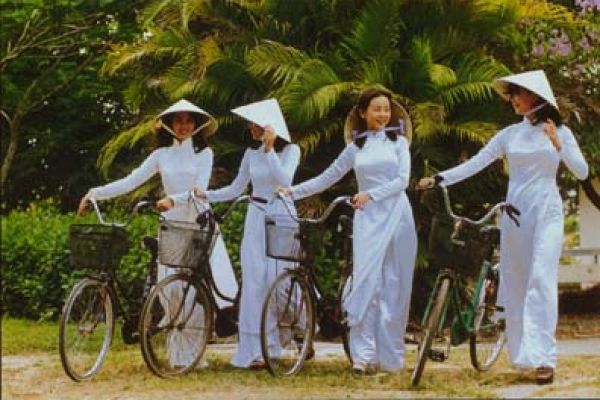Most Vietnamese people wear new clothes to celebrate Tet, or the Lunar new year, in order to promote a fresh beginning to the year. Although Western-style outfits are more convenient for daily chores, the traditional tunic, or ao dai, reappears each Tet. These tunics add to the festival’s formal atmosphere.
In the past, all ao dai were lined. The two layers of fabric formed a set, or kép(in Vietnamese). On formal occasions, another light ao dai, always white, was worn as an undergarment under the kép to form a triple set of layers called mớ ba. This was the proper way to wearao dai until only a few decades ago. To deal with sudden encounters, such as the frequent visitors who often drop in without notice around Tet, a “hasty”ao dai could be thrown over whatever the host was wearing. From the mid-1950s, the ao dai was simplified and the kép layer eliminated.
For centuries, male and female ao dai were cut similarly, except that the neck of the women’s ao dai was about two cm high, while the male collar measured 3.5cm. The wide, down-curved hem, about 80cm across, hung about 10cm below the knee. Royal’s ao dai were of standard cut but were fashioned in different colors and materials.
Long ago city ladies had their ao dai made from colorful silk brocades and lampas. French influence popularized velvets in shades of burgundy, dark green and dark blue. While town women wore five-paneledao dai, or nam ta, women in the countryside had front-opening four-panel ao dai called tu than. The rural tu than were made from hemp-based fabrics, normally in a brown or brownish-fuchsia color.
The tu than tunics worn by wealthy countryside people at Tet were beautiful,with eight flowing silk strips in front. The inner-most layer featured two strips in the color of a lotus flower, about two meters long and 25cm wide, which wrappered around the waist and the knotted to make a bow in front. Next came the two long ends of a light yellow crepe money belt, and finally a bow and strips formed by a soft green silk belt. The two dark brown front flaps of thetunic were lightly tied under those strips to enhance their vivid colors.
Well-dressed Men
As for men’s ao dai, father Cristoforo Borri, an Italian Catholic priest who traveled through the northern Principality (today’s northern Vietnam) in the 17th century, wrote in his 1631 book “Relations de la Nouvelle Mission des Peres de la Compagnie de Jesus au Royaume de la Cochinchine” that most northern men wore a blackao dai over other layers on most festive occasions. This remained unchanged in Vietnam until recently.
Traditional ao dai pants were moderately wide with a low crotch. Conventionally, married women wore black satin pants with their ao dai. Young maidens and men wore white ao dai pants. In Hue people of all ages and sexes wore only white pants. Hue’s upper-classes of both sexes added tree pleats to their pant’s outer edges so that the pants flared out when they moved. These pleated pants are called chít-ba.
Following the mishaps of history that have marred so many traditions, Vietnam is bouncing back in peace time. With Vietnamese people’s innate pride in their culture, it will not be long until visitors can witness a traditional Vietnamese Tet, complete with authentic and colorful ao dai.



